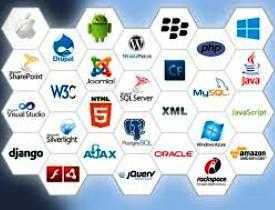Description
Course Name: Master in Computer Software and Hardware Technology
Course Id: MCSHT/Q0001.
Education Qualification: 12th Pass.
Duration: 370 Hrs.
How You will Get Diploma Certificate:
Step 1- Select your Course for Certification.
Step 2- Click on Enroll Now.
Step 3- Proceed to Enroll Now.
Step 4- Fill Your Billing Details and Proceed to Pay.
Step 5- You Will be Redirected to Payment Gateway, Pay Course and Exam Fee by Following Options.
Card(Debit/Credit), Wallet, Paytm, Net banking, UPI and Google pay.
Step 6- After Payment You will receive Study Material on your email id.
Step 7- After Completion of Course Study give Online Examination.
Step 8- After Online Examination you will get Diploma Certificate soft copy(Scan Copy) and Hard Copy(Original With Seal and Sign).
Step 9- After Certification you will receive Prospect Job Opportunities as per your Interest Area.
Online Examination Detail:
- Duration- 120 minutes.
- No. of Questions- 60. (Multiple Choice Questions).
- 10 Questions from each module, each carry 10 marks.
- Maximum Marks- 600, Passing Marks- 40%.
- There is no negative marking in this module.
| How Students will be Graded: | ||
| S.No. | Marks | Grade |
| 1 | 91-100 | O (Outstanding) |
| 2 | 81-90 | A (Excellent) |
| 3 | 71-80 | A (Very Good) |
| 4 | 61-70 | B (Good) |
| 5 | 51-60 | C (Average) |
| 6 | 41-50 | P (Pass) |
| 7 | 0-40 | F (Fail) |
Benefits of Certification:
- Government Authorized Assessment Agency Certification.
- Certificate Valid for Lifetime.
- Lifetime Verification of Certificate.
- Free Job Assistance as per your Interest Area.
Syllabus
Master In Computer Software And Hardware Technology
Principles of Operating System and Compiler
Memory organization & management: memory organization, memory hierarchy, memory management strategies, contiguous versus non- contiguous memory allocation, partition management techniques, logical versus physical address space, swapping, paging, segmentation, segmentation with paging, virtual memory,processes: introduction, process states, process management, interrupts, interprocess communication threads, processor scheduling, process synchronization, deadlocks, device management, file system, i/o systems,the compiler toolchain, stages within a compiler, kinds of tokens, a hand-made scanner, limits of finite automation.
Computer Hardware & Maintenance
Demonstrate implementation of safe working practices, environment regulation, and housekeeping, demonstrate testing and troubleshooting for power supplies in i/o devices and trace circuit of pc smps, advance computer hardware, preventive maintenance and troubleshooting of pc, assemble and repair desktop computer with all its hardware components, install different operating system and all other application software, customize operating system and maintenance of system application software, collaboration, surveillance and maintenance through network, install and configure windows and linux server, browse internet and communicate through email, virtualization, cloud concepts & services, install printer, scanner and troubleshoot their faults.
Network Administration
Introduction to cyber security, Introduction to cyber security, Risk Assessment, Physical security, System Security, Introduction to networking, – MS based Network administration, Introduction to Windows, Windows Server, Domain controller, Active directory, Files, permissions and offline files, EFS, Computer networks, Introduction to computer communications, Cisco introduction, VLAN, Trunk and DTP, VTP, Port Security, CDPLLDP, STP, Etherchannel, NTP, InterVLAN Routing, Static routes, Dynamic routing protocols: RIP, OSPF, EIGRP, BGP, GRE Tunnels, ACLs NAT, IPv6, HSRP, WAN technologies.
Software Engineering
Introduction, definition, objectives, Life cycle – Requirements analysis and specification. Design and Analysis: Cohesion and coupling, Data flow oriented Design: Transform centered design, Transaction centered design. Analysis of specific systems like Inventory control, Reservation system, Object-oriented Design: Object modeling using UML, use case diagram, class diagram, interaction diagrams: activity diagram, unified development process, Implementing and Testing: Programming language characteristics, fundamentals, languages, classes, coding style efficiency. Testing: Objectives, black box and white box testing, various testing strategies, Art of debugging. Maintenance, Reliability and Availability: Maintenance: Characteristics, controlling factors, maintenance tasks, side effects, preventive maintenance – Re Engineering, Software quality: SEI CMM and ISO-9001. Software reliability and fault-tolerance, software project planning, monitoring, and control. Computer-aided software engineering (CASE), Component model of software development, Software reuse.
Programming Using C and C
Introduction Of Programming Languages, ‘C’ Tokens, Control Statement And Expressions, Looping, Arrays And String, Functions, Pointers, Structure And Unions, File Handling Using ‘C’, Dynamic Memory Allocation, Storage Classes And Pre-Processor, Introduction To Object Oriented Programming, ‘C ’ Tokens And Type Casting, Classes &Objects, Function In ‘C ’, Constructors And Destructor, Operator Overloading, Inheritance, Working With Files, Exception Handling.
Software Project Management
The role of project Manager, The project Management Profession, Project life cycle, Developing the project schedule, Project management software tools, Developing the project budget, Finalizing the project schedule and budget, The importance of project risk management, Risk management planning, Common sources of risk on information technology projects, Risk identification, Qualitative risk analysis, Quantitative risk analysis, Risk response planning, The importance of project procurement management, Planning purchase and acquisitions, Planning contracting, Requesting seller responses, Selecting sellers, Administering the contract, Change management, Leadership & Ethics in Projects, Administrative closure, Project evaluation.
Computer Hardware and Troubleshooting Lab
Computer Hardware and Troubleshooting Lab, Identification of symptoms for failure, Beep codes and error codes, Different symptoms of motherboard, Beep, error and symptoms failure of FDDI, Keyboard interface, Beep, error and symptoms of failure of keyboard, Identification of Hardware elements, To Assembling a Computer, – Formatting disk drives, Creation of Logical Disk Drives, Installation of device drivers, Understanding control panel settings, Working with antivirus software (To learn how to use antivirus software and remove virus).

